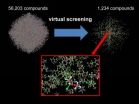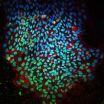(Press-News.org) Researchers at the National Institute of Standards and Technology (NIST) have developed a new computational method for identifying candidate refrigerant fluids with low "global warming potential" (GWP) — the tendency to trap heat in the atmosphere for many decades — as well as other desirable performance and safety features.
The NIST effort is the most extensive systematic search for a new class of refrigerants that meet the latest concerns about climate change. The new method was used to identify about 1,200 promising, low-GWP chemicals* for further study among some 56,000 that were considered. Only about 60 of these have boiling points low enough to be suitable for common refrigeration equipment, an indication of how difficult it is to identify usable fluids.
The ongoing NIST project is a response to U.S. industry interest in a new generation of alternative refrigerants that already are required for use in the European Union.
The refrigerants now used in cars and homes are mainly hydrofluorocarbons (HFCs). They were adopted a generation ago in the effort to phase out chlorofluorocarbons (CFCs), which deplete the stratospheric ozone layer. An example is R-134a (1,1,1,2-tetrafluoroethane), which replaced ozone-depleting chemicals in automobile air conditioners and home refrigerators. R-134a now is being phased out in Europe because HFCs remain in the atmosphere for many years, yielding a high GWP. A compound's GWP is defined as the warming potential of one kilogram of the gas relative to one kilogram of carbon dioxide. R-134a has a GWP of 1,430, much higher than the GWP of 150 or less now mandated for automotive use in Europe.
Promising low-GWP chemicals include fluorinated olefins, which react rapidly with atmospheric compounds and thus will not persist for long periods.
"What industry is trying to do is be prepared, because moving from a GWP in the thousands or tens of thousands to a GWP of 150 is an enormous challenge, both economically and technologically," says NIST chemist Michael Frenkel. "We decided to leverage the tools NIST has been developing for the last 15 years to look into the whole slew of available chemicals."
The affected industry is huge: The U.S. air conditioning, heating and refrigeration equipment manufacturing industry ships about $30 billion in goods annually, according to the U.S. Bureau of the Census.
NIST has extensive experience evaluating alternative refrigerants, having previously helped the refrigeration industry find replacements for CFCs.**
The new NIST method estimates GWP by combining calculations of a compound's radiative efficiency (a measure of how well it absorbs infrared radiation) and atmospheric lifetime, both derived from molecular structure. Additional filtering is based on low toxicity and flammability, adequate stability, and critical temperature (where the compound's liquid and gas properties converge) in a desirable range. The method was applied to 56,203 compounds and identified 1,234 candidates for further study. The method, which was validated against available literature data, is accurate and fast enough for virtual screening applications. The approach is similar to the large-scale virtual screening and computational design methods for discovering new pharmaceuticals.
The screening is the initial stage of a larger study funded by the U.S. Department of Energy. The next step will be to further narrow down the candidates to a couple dozen suitable for detailed investigation in refrigeration cycle modeling.
INFORMATION:
* A. Kazakov, M.O. McLinden and M. Frenkel. Computational design of new refrigerant fluids based on environmental, safety, and thermodynamic characteristics. Industrial and Engineering Chemistry Research. Article ASAP, Publication Date (Web): September 4, 2012. DOI: 10.1021/ie3016126
**See 2007 NIST Tech Beat article, "NIST Releases Major Update of Popular REFPROP Database," at www.nist.gov/public_affairs/techbeat/tb2007_0412.htm#refprop.
New NIST screening method identifies 1,200 candidate refrigerants to combat global warming
2012-09-19
ELSE PRESS RELEASES FROM THIS DATE:
Discovery of reprogramming signature may help further stem cell-based regenerative medicine research
2012-09-19
LA JOLLA, CA---- Salk scientists have identified a unique molecular signature in induced pluripotent stem cells (iPSCs), "reprogrammed" cells that show great promise in regenerative medicine thanks to their ability to generate a range of body tissues.
In this week's Proceedings of the National Academy of Sciences, the Salk scientists and their collaborators at University of California, San Diego, report that there is a consistent, signature difference between embryonic and induced pluripotent stem cells. The findings could help overcome hurdles to using the induced stem ...
Sandia shows monitoring brain activity during study can help predict test performance
2012-09-19
ALBUQUERQUE, N.M. — Research at Sandia National Laboratories has shown that it's possible to predict how well people will remember information by monitoring their brain activity while they study.
A team under Laura Matzen of Sandia's cognitive systems group was the first to demonstrate predictions based on the results of monitoring test volunteers with electroencephalography (EEG) sensors.
For example, "if you had someone learning new material and you were recording the EEG, you might be able to tell them, 'You're going to forget this, you should study this again,' ...
Major changes needed to protect Australia's species and ecosystems
2012-09-19
A study has highlighted the sensitivity of Australia's species and ecosystems to climate change, and the need for new ways of thinking about biodiversity conservation.
'Climate change is likely to start to transform some of Australia's natural landscapes by 2030,' lead researcher, CSIRO's Dr Michael Dunlop said.
'By 2070, the ecological impacts are likely to be very significant and widespread. Many of the environments our plants and animals currently exist in will disappear from the continent. Our grandchildren are likely to experience landscapes that are very different ...
NYU neuroscientists find promise in addressing Fragile X afflictions
2012-09-19
Neuroscientists at New York University have devised a method that has reduced several afflictions associated with Fragile X syndrome (FXS) in laboratory mice. Their findings, which are reported in the journal Neuron, offer new possibilities for addressing FXS, the leading inherited cause of autism and intellectual disability.
Those afflicted with FXS do not possess the protein FMRP, which is a suppressor of protein synthesis. Absent this suppressor, protein synthesis is exaggerated, producing a range of mental and physical disorders.
Previous research has indirectly ...
Scientists show biological mechanism can trigger epileptic seizures
2012-09-19
CINCINNATI – Scientists have discovered the first direct evidence that a biological mechanism long suspected in epilepsy is capable of triggering the brain seizures – opening the door for studies to seek improved treatments or even preventative therapies.
Researchers at Cincinnati Children's Hospital Medical Center report Sept. 19 in Neuron that molecular disruptions in small neurons called granule cells – located in the dentate gyrus region of the brain – caused brain seizures in mice similar to those seen in human temporal lobe epilepsy.
The dentate gyrus is in the ...
Autism symptoms could arise from unreliable neural responses
2012-09-19
Diverse symptoms associated with autism could be explained by unreliable activity of neurons in the brain in response to basic, nonsocial sensory information, according to a study published by Cell Press on September 19th in the journal Neuron. The new findings suggest that autism is a disorder of general neural processing and could potentially provide an explanation for the origins of a range of psychiatric and neurological disorders.
"Within the autism research community, most researchers are looking for either a dysfunctional brain region or inadequate connections ...
Autistic adults have unreliable neural responses, Carnegie Mellon-led research team finds
2012-09-19
VIDEO:
New research led by Carnegie Mellon University neuroscientists takes the first step towards deciphering the connection between general brain function and the emergent behavioral patterns in autism. Published in...
Click here for more information.
PITTSBURGH— Autism is a disorder well known for its complex changes in behavior — including repeating actions over and over and having difficulty with social interactions and language. Current approaches to understanding ...
Neuroscientists investigate lotteries to study how the brain evaluates risk
2012-09-19
People are faced with thousands of choices every day, some inane and some risky. Scientists know that the areas of the brain that evaluate risk are the same for each person, but what makes the value assigned to risk different for individuals? To answer this question, a new video article in Journal of Visualized Experiments (JoVE) uses functional magnetic resonance imaging (fMRI) to characterize subjective risk assessment while subjects choose between different lotteries to play. The article, a joint effort from laboratories at Yale School of Medicine and New York University, ...
Nearly half of kidney recipients in live donor transplant chains are minorities
2012-09-19
The largest U.S. multicenter study of living kidney transplant donor chains showed that 46 percent of recipients are minorities, a finding that allays previous fears that these groups would be disadvantaged by expansion of the donor pool through this type of exchange process.
The study of a series of chain transplantations performed from February 2008 to June 2011 at 57 centers nationwide included 272 kidney transplants that paired organ donors who were incompatible with their relatives with strangers providing organs for altruistic reasons or with others donating an ...
Warming ocean could start big shift of Antarctic ice
2012-09-19
Fast-flowing and narrow glaciers have the potential to trigger massive changes in the Antarctic ice sheet and contribute to rapid ice-sheet decay and sea-level rise, a new study has found.
Research results published in the journal Proceedings of the National Academy of Sciences reveal in more detail than ever before how warming waters in the Southern Ocean are connected intimately with the movement of massive ice-sheets deep in the Antarctic interior.
"It has long been known that narrow glaciers on the edge of the Antarctica act as discrete arteries termed ice streams, ...





